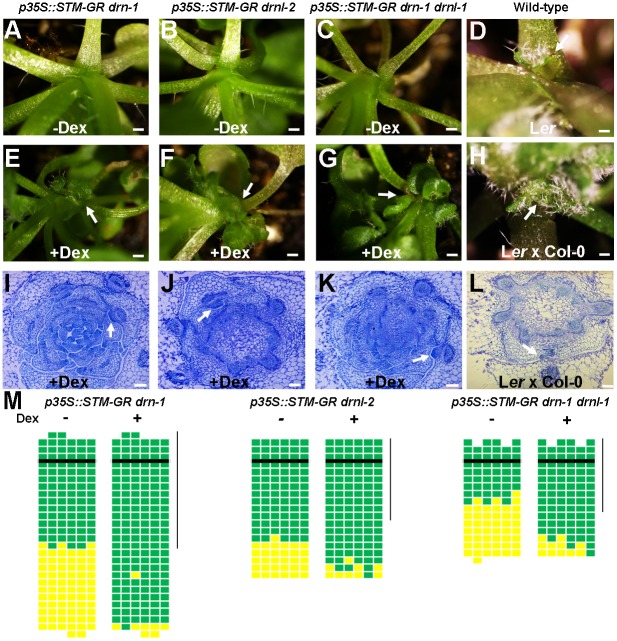Fig. 4.
Overexpression of STM rescues axillary bud deficiency in drn and drnl mutants. (A-C) Higher magnification of rosette leaf axils in mock-treated p35S::STM-GR drn-1 (A), p35S::STM-GR drnl-2 (B) and p35S::STM-GR drn-1 drnl-1 (C) plants showing the absence of an axillary bud. (E-G) Higher magnification of rosette leaf axils in Dex-treated p35S::STM-GR drn-1 (E), p35S::STM-GR drnl-2 (F) and p35S::STM-GR drn-1 drnl-1 (G) plants showing the presence of axillary buds (arrows). (D,H) Higher magnification of rosette leaf axils in mock-treated Ler and mixed Ler×Col-0 ecotypes showing the presence of axillary buds (arrows). (I-L) Transverse sections through vegetative shoot apices of 28-day-old Dex-treated p35S::STM-GR drn-1 (I), p35S::STM-GR drnl-2 (J), p35S::STM-GR drn-1 drnl-1 (K) and mixed Ler×Col-0 ecotypes (L) stained with Toluidine Blue O, showing the presence of axillary buds (arrows) in rosette leaf axils. (M) Schematic representation of axillary buds in leaf axils with or without Dex induction. Green indicates the presence of an axillary bud; yellow indicates the absence of an axillary bud. Plants were grown under short-day conditions for 15 days without treatment; leaf axil regions were treated with 10 µM Dex every second day for another 15 days and then transferred to long-day conditions without treatment until axillary buds were counted. The vertical line indicates leaves initiated during Dex treatment. Horizontal lines indicate the border between the youngest rosette leaf and the oldest cauline leaf. Scale bars: 2 cm in A-H; 100 μm in I-L.

